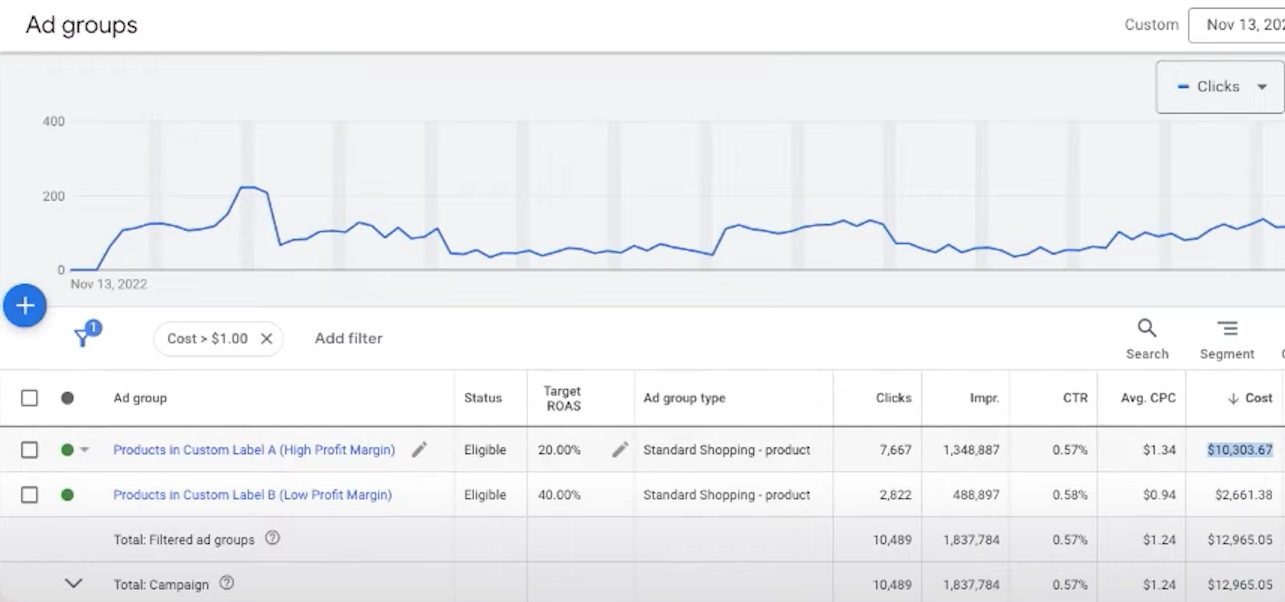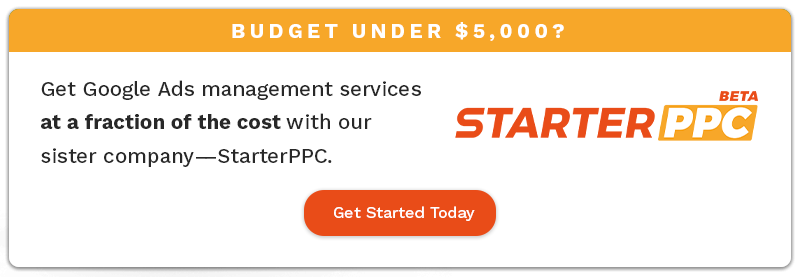Learn the secret to maximizing your Google Ads budgets as we unveil a game-changing strategy for businesses with limited budgets and a wide range of products.
This proven strategy is excellent for those working with a few hundred or even thousands of products with only a small budget.
When working with smaller budget clients, we have noticed that Google’s algorithm focuses on only a couple of products out of hundreds our clients have listed on their site. And we think this happens because Google spends some money here and then notices a conversion and leans into that SKU, whether it converts again or not.
The algorithm hooks on to that conversion, tries to become more familiar with that product, and eventually isn’t willing to experiment independently. Instead, it tries to optimize for that one product and get you the best return for your dollar.
Reasons you might believe that selling another product might be more beneficial
There could be several reasons for this. For instance, you may have high profit margin products that generate double the revenue compared to other products. In such cases, you want the algorithm to prioritize those products.
It could also be driven by inventory concerns, where you want to clear out last season’s stock.
Additionally, it may be a strategic move where you aim to upsell customers from introductory-level products to more advanced ones. However, the algorithm is currently promoting products that aren’t in high demand, which are meant for upselling.
How can you make the algorithm prioritize other products?
In the past, our strategy involved splitting the Shopping campaign into two, which is feasible with higher budgets. However, with tight budget restrictions, your daily spend may only generate a few clicks per day.
This is why you want to keep your budgets the same because the algorithm needs more daily spend to achieve a consistent frequency of conversions in each campaign. It receives a conversion, waits for a month, and loses track of potential customers, their current interest, and the valuable data obtained from a single conversion weeks ago.
The strategy we recommend
We advise setting up a Standard Shopping campaign.
In the given account, with a daily budget of $60, allocating funds to a Performance Max (PMax) campaign is not advisable. Therefore, there is no urgency to set up a PMax campaign alongside the Standard Shopping campaign.
Now for this strategy, you have to use Standard Shopping because PMax can’t do what we’re about to explain to you in this strategy.
Take a look inside this Standard Shopping campaign below.
What you can see here is we’ve split the campaigns down the middle into two ad groups.
One that is the highest profit margin and one that is the lowest profit margin products.
You can do this by adding a custom label in the feed.
We have custom label A and custom label B, allowing us to manipulate the bidding strategy separately on one category versus the other to focus the algorithm in one direction.

So you can see here that the high profit margin products have a target ROAS of only 20%, and the low profit margin products have a target ROAS that is double. Now, it doesn’t matter what these numbers are; you could set them to 80 and 160 or put them even higher if you want.

Although, we have found that setting a low target ROAS in Standard Shopping can be beneficial.
Note that setting a higher target ROAS imposes greater restrictions on the campaign.
For instance, if you aim for a 300% ROAS and set it as your target, the algorithm becomes limited in its actions unless it predicts a x3 return. Initially, this approach might yield results for a few days. However, the algorithm may eventually need help to achieve the desired x3 return, leading to reduced spending or ignoring the target ROAS goal altogether.
We opt for a less restrictive, lower target ROAS
We do this, particularly in high profit margin scenarios, allowing the algorithm more freedom to spend and optimize for better results.
Increasing spend in an ad group with more expensive products may lower the overall ROAS in the account. This is true, at least in the short term. In an ad group comprising competitive, high-priced products with a lower conversion rate and higher cost per click, the ROAS will be lower.
However, this temporary decrease in ROAS is part of a strategy to influence the algorithm’s focus and familiarize it with your preferred products over the long term. It is important to note that this approach may not bring instant success in terms of ROAS, as shifting the algorithm’s focus to new and unfamiliar products will initially result in a temporary decline in ROAS.
We advise against implementing extreme measures and instead recommend a gradual approach. For instance, you can allocate 30% of the budget to one group, another 30% to another group, and then gradually decrease it by 5% each week until reaching the desired level. The results within this account demonstrate the effectiveness of this strategy.
Since mid-November, we have implemented this approach in the account, manipulating the bids over time. As a result, an increasing portion of the budget is allocated to high profit margin products.

The strategy here is not to abruptly restrict spending on low profit margin products, as it divides the budget. Instead, the approach is to set a higher return expectation for those products while allowing the algorithm flexibility in spending.
This results in a higher return for low profit margin products and a lower return for high profit margin products. However, the discrepancy in ROAS should not be the sole determining factor in product selection.
It’s essential to prioritize what is best for the business.
Despite spending less than half the budget on low profit margin products, the ROAS doesn’t always double as expected.
Tip: For highly seasonal accounts, try splitting the ad groups by Summer vs. Winter. This gives you a lever to pull when the weather changes to speed up the process of getting the algorithm to invest in the season’s products.
This strategy requires patience and gradual manipulation of the algorithm over time. The focus should be on letting the algorithm learn and setting low target ROAS goals in the Standard Shopping campaign while making bid adjustments.
If you have yet to hear of StarterPPC, it’s our sister agency that works with monthly ad spend budgets under $5,000. Learn how StarterPPC can help grow your business without breaking the bank.
Author
Ashleigh is a Content Writer at Solutions 8. When she isn’t writing, you can find her in the Alps sipping the finest wine, walking in the mountains, or admiring the crystal blue waters of the river flowing near her home. She’s an avid Pokemon card collector and a massive fan of anything that screams ’90s nostalgia.
 Ashleigh Stearn
Ashleigh Stearn












